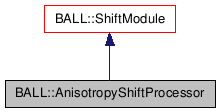BALL::AnisotropyShiftProcessor Class Reference
[Shift
modules]
Shift assignment
processor implementing Anisotropy. More...
#include <anisotropyShiftProcessor.h>

Public Member Functions |
|
|
Constructors and Destructors
|
|
| AnisotropyShiftProcessor () | |
| Default constructor. |
|
| AnisotropyShiftProcessor (const AnisotropyShiftProcessor &processor) | |
| Copy constructor. |
|
| virtual | ~AnisotropyShiftProcessor () |
| Destructor. |
|
|
Processor specific functions.
|
|
| virtual bool | finish () |
| Finish method. |
|
| virtual Processor::Result | operator() (Composite &composite) |
| Application method. |
|
|
Accessors
|
|
| virtual void | init () |
| Module initialization. |
|
Static Public Attributes |
|
|
Enums and Constants
|
|
| static const char * | PROPERTY__ANISOTROPY_SHIFT |
| A symbolic name for the electric
field contribution to the chemical shift. |
|
Protected Attributes |
|
| std::list< const Atom * > | proton_list_ |
| std::list< const Bond * > | eff_list_ |
| std::list< const Bond * > | eff_list_2_ |
| bool | ignore_other_chain_ |
Detailed Description
Shift assignment processor implementing Anisotropy.Member Function Documentation
| virtual bool BALL::AnisotropyShiftProcessor::finish | ( | ) | [virtual] |
Finish method.
Here chemical shift calculation is done. An iteration
over every Hydrogen in proton_list_ is
started. For each of these Hydrogens an iteration is
started over every effector bounds in
eff_list_. c_atom is assigned the
first atom of effector bond and o_atom is the
second. If the actual proton is in another residue then
c_atom calculation is started. The next
bounded carbonate atom of c_atom is stored in
x_atom. Now we have three atoms with their
positions stored in c_pos , o_pos
and x_pos.
- We then build a cartesian coordinate system with these vectors.
vz=o_pos-c_posand vz is normalized.vyis the vectorproduct of vz and the difference vector ofx_posandc_posand is normalized.vxis the vectorproduct of vz and vy and is normalized. Then the centercenof the effector bound is set to
c_pos
+ 1.1 * vz.
- Next three vectors are calculated :
v1is the difference vector of the actual hydrogen andcen.v2is the vectorproduct ofv1andvy.v3is the vectorproduct ofv2andvx.abstandis assigned the length of vectorv1. Thensthetais assigned the sinus of the angle betweenv1andvy. The sinus of the angle betweenv2andvxis assigned tosgamma. Now preparations have finished and we can start the real shift calculation.
calc1=dX1* ( ( 3.0 *stheta*stheta) - 2.0 ).
calc2=dX2* ( 1.0 - ( 3.0 *stheta*stheta*sgamma*sgamma) )
ts= (calc1+calc2) / ( 3.0 *distance*distance*distance)
tsis added togs.
dX1anddX2are some constant floats. If the actual Hydrogens name is "H" the constant floatsdXN1anddXN2are used instead.
- If
eff_list_has finished C=O anisotropy for actual Hydrogen is done and iteration over all C=N anisotropy effector bounds ofeff_list_2_is started.
- This calculation is very similar with just some
differences : We got three position vectors called:
c_poso_posposition ofn_posposition of the Nitrogen bonded to Carbonate.
- The cartesion coordinate system is built on
vz=n_pos-c_pos
vyis the vectorproduct ofvzand the difference vector ofo_posandc_pos
vxis the vectorproduct ofvzandvy.
- The center of the effector bond is set to:
cen=c_pos+ (vz* ( 0.85 * length ofvz) )
- The final calculation is just the same as above,
except the use of different constants. Use
ndX1andndX2instead ofdX1anddX2andndXN1andndXN2intead ofdXN1anddXN2. Finally C=N anisotropy has finished andgsis added to the actual hydrogens shift. Then iteration goes on with the next hydrogen.
Reimplemented from BALL::ShiftModule.
| virtual Processor::Result BALL::AnisotropyShiftProcessor::operator() | ( | Composite & | composite | ) | [virtual] |
Application method.
Atoms are stored in three different lists , named
proton_list_that contains all Hydrogens,
eff_list_that contains all effectors of C=O anisotropy and
eff_list_2_that contains all effectors of C=N anisotropy. Effectors of C=O anisotropy are all bounds between atoms named "C" and "O", as well as bounds between atoms named "CG" and "OD1" in residues called "ASP" or "ASN, and finally bounds between atoms named "CD" and "OE1" in residues called "GLU" and "GLN". Effectors of C=N anisotropy are all bounds between atoms named "C" and "N".
Reimplemented from BALL::UnaryProcessor< Composite >.
Member Data Documentation
const char*
BALL::AnisotropyShiftProcessor::PROPERTY__ANISOTROPY_SHIFT
[static] |
A symbolic name for the electric field contribution to the chemical shift.
- See also:
- ShiftModule::PROPERTY__SHIFT
 1.5.8
1.5.8